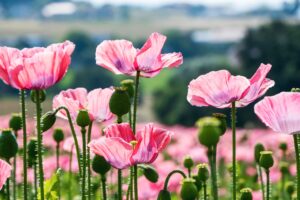Scabiosa, commonly known as the pincushion flower, is a charming perennial that adds whimsy and beauty to any garden landscape. With its delightful blooms and easy-care nature, Scabiosa is a favorite among gardeners. Here’s everything you need to know to grow and care for this lovely plant.
Best Scabiosa Varieties
| Image | Name | Rating | Shop |
|---|---|---|---|
 | Double Scabiosa Pincushion Flower Seed Mix |  | |
 | Scabiosa Pin Cushion Mourning Bride Flower Seeds |  |
Scabiosa Hardiness Zones
Scabiosa plants are hardy in USDA zones 3 to 7, making them suitable for a wide range of climates. These perennials are known for their ability to return year after year, bringing joy to gardens with their abundant blooms.
How Much Sun Do Scabiosa Need
To thrive, Scabiosa plants require full sun, meaning they need at least six hours of sunlight each day. Plant them in a location where they can bask in the sun’s rays, soaking up its energy to produce an abundance of beautiful flowers. While Scabiosa can tolerate partial shade, it may result in fewer blooms and less vigorous growth.
Scabiosa Soil Requirements
Provide Scabiosa with well-drained soil that retains moisture but does not become waterlogged. Loamy or sandy soil types are ideal for Scabiosa cultivation, as they offer good drainage while retaining essential moisture. Before planting, amend heavy clay soils with organic matter such as compost or peat moss to improve drainage and soil structure.
Scabiosa Soil pH
Scabiosa plants prefer soil with a neutral to alkaline pH, typically ranging from 6.5 to 8.0. Conduct a soil pH test before planting to ensure the soil acidity is within the desired range. If necessary, adjust the pH by adding lime to raise acidity or sulfur to lower acidity, providing optimal growing conditions for your Scabiosa plants.
Scabiosa Plant Spacing
When planting Scabiosa, space the plants approximately 12 to 18 inches apart to allow for adequate air circulation and prevent overcrowding. This spacing ensures that each plant has ample room to grow and spread its foliage and flowers without competition from neighboring plants.
Scabiosa Water Requirements
While Scabiosa is relatively drought-tolerant once established, it still requires regular watering, especially during dry spells or hot weather. Aim to provide about an inch of water per week, ensuring that the soil remains evenly moist but not waterlogged. Avoid overhead watering, as it can lead to fungal diseases and foliage damage. Instead, water at the base of the plant to deliver moisture directly to the roots.
Scabiosa Temperature Requirements
Scabiosa plants thrive in moderate temperatures, preferring climates with mild summers and cool winters. They are not fond of extreme heat, so provide afternoon shade in hot summer regions to protect them from intense sun exposure. Additionally, mulching around the base of the plants can help regulate soil temperature and moisture levels, promoting optimal growth.
Scabiosa Humidity Requirements
Scabiosa plants prefer low humidity environments, making them suitable for regions with dry or arid climates. However, they can adapt to moderate humidity levels as long as there is adequate airflow around the plants to prevent moisture buildup and minimize the risk of fungal diseases.
Scabiosa Fertilizer Requirements
Scabiosa is considered a light feeder and typically does not require heavy fertilization. Apply a balanced fertilizer sparingly in spring or early summer to provide essential nutrients for healthy growth and flowering. Avoid over-fertilizing, as it can lead to excessive foliage growth at the expense of flower production.
Scabiosa Pests
Keep an eye out for common garden pests that may affect Scabiosa plants, including aphids, slugs, spider mites, and thrips. Regularly inspect the foliage for signs of pest infestation, such as distorted leaves or sticky residue. If pests are detected, treat the affected plants promptly with insecticidal soap or neem oil to control the infestation and prevent further damage.
Scabiosa Diseases
Scabiosa plants are susceptible to fungal diseases such as leaf spot, root rot, and powdery mildew, especially in humid or poorly ventilated conditions. To minimize the risk of disease, avoid overhead watering and provide adequate spacing between plants to promote airflow. Remove any diseased foliage promptly and dispose of it properly to prevent the spread of infection. Additionally, apply fungicidal treatments as needed to protect your Scabiosa plants from fungal diseases.
By following these tips and providing proper care, you can enjoy the beauty of Scabiosa plants in your garden year after year. With their charming pincushion-like flowers and easy-going nature, Scabiosa is sure to delight both novice and experienced gardeners alike.
















